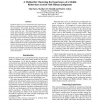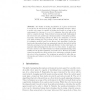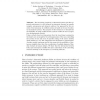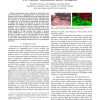682 search results - page 29 / 137 » Autonomous Environment and Task Adaptation for Robotic Agent... |
AAAI
2000
13 years 9 months ago
2000
If robotic agents are to act autonomously they must have the ability to construct and reason about models of their physical environment. For example, planning to achieve goals req...
IBPRIA
2005
Springer
14 years 1 months ago
2005
Springer
The ability of finding its situation in a given environment is crucial for an autonomous agent. While navigating through a space, a mobile robot must be capable of finding its lo...
EUROS
2008
13 years 9 months ago
2008
Abstract. The increasing complexity of humanoid robots and their expected performance in real dynamic environments demand an equally complex, autonomous and dynamic solution. Our a...
IROS
2007
IEEE
14 years 2 months ago
2007
IEEE
Abstract—Autonomous robot navigation in unstructured outdoor environments is a challenging area of active research. The navigation task requires identifying safe, traversable pat...
IROS
2006
IEEE
14 years 1 months ago
2006
IEEE
Abstract— Linking semantic and spatial information has become an important research area in robotics since, for robots interacting with humans and performing tasks in natural env...




